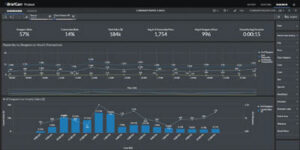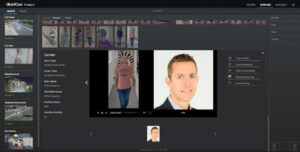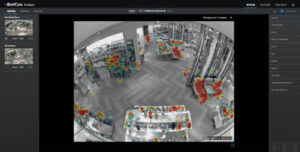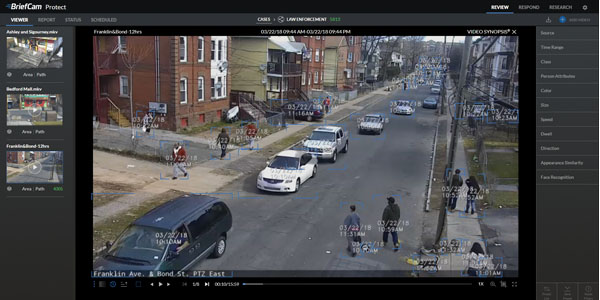Modern video surveillance systems are capable of capturing real-time high-resolution image streams around the clock, delivering a huge amount of data to operators. This data contains a wealth of information which can be of great value to those managing a site, including security, safety and the operational procedures of the businesses. However, despite the benefits which can be realised, all too often this data is not used. BriefCam, the provider of a leading smart video analysis platform, argues the true value of captured data can now be realised thanks to developing technologies.
Because humans exist in a predominantly visual world, we are able to extrapolate significant and vital data from things we view, whether they be local events or those transmitted by a video system. Even a short video stream contains a huge amount of information which can be applied to make sense of situations and assist with decision making. In applications where the sole focus is security, it is rare for the wealth of captured data to be viewed, let alone processed, unless an exceptional event occurs. As a result, much of the value inherent in video is lost.
In security-focused surveillance applications, the typical approach is to archive as much captured data as is affordable, and this is then stored for a defined period of time. The duration of storage is usually arrived at using two considerations: the needs of the site and the cost of long-term archiving. If, during the period of storage, there are no reports of events, incidents or alarms, the oldest footage is over-written. This happens without the recorded data being used in any way or for any purpose.
If an incident is reported, then attempts are made to identify relevant video clips, and these are used to assess the event and identify any persons of interest for further investigation or evidential purposes. In some cases, it might be possible to search for other related incidents or appearances of suspects to try and create a better understanding of what occurred in the lead-up the incident. However, where a large number of camera streams are archived, this process can be both time consuming and labour intensive.
 Therefore, it has to be accepted with most video surveillance applications, a significant percentage of captured data is never even viewed, let alone examined or analysed to gain insights into site status. Additionally, when an incident occurs, often a lack of resources will prevent all relevant video data being found and used. In an age of smart systems, this has to be recognised as a failing of many systems.
Therefore, it has to be accepted with most video surveillance applications, a significant percentage of captured data is never even viewed, let alone examined or analysed to gain insights into site status. Additionally, when an incident occurs, often a lack of resources will prevent all relevant video data being found and used. In an age of smart systems, this has to be recognised as a failing of many systems.
Before looking at how the efficiency of video surveillance systems can be improved, it is worth taking a moment to think about the data which is contained in a simple video clip. Obviously, video shows the actions and activities in a viewed scene, often in real-time. This information can be of great value, but to make use of it, filtering and object recognition is essential. In traditional surveillance systems, these tasks are usually carried out by a human operator. Because of the visual nature of video, system operators can deliver a high level of filtering and recognition. However, the process can be time-consuming and is often not efficient.
Data available from captured video includes – but is not limited to – movement, repetitive motion, inactivity, speed, direction, size, shape, colour, object classification, brands and makes, facial details, gender, age, etc.. Because humans are trained from birth to recognise objects and filter various details about them, this can be achieved whether looking at a local scene or viewing it remotely on video.
It is this very depth of detail which makes video such a valuable tool for businesses and organisations.
Whether for security, life safety, site management, business efficiencies or other tasks, video data includes a huge number of identifiers which help ensure an excellent level of situational awareness.
Of course, this basic example highlights something that often lets video surveillance systems down: the sheer volume of information available from video recordings. In multi-camera applications, it is not realistic to expect operators to view every stream of video and log all the contained information. Any efficiencies achieved from the use of the captured data are soon eroded by the labour costs and required resources to process the information. However, with the advent of smart video analytics platforms, the data can be used for a host of purposes ranging from security and safety through to business intelligence and site management. This can all be achieved without the need for labour-intensive practices.
BENEFITS OF SMART ANALYTICS PLATFORMS TO END USERS
The benefit of AI-driven analytics
 While system operators can apply reasoning and logic to visual information contained in video streams, thereby deciding which actions and responses are necessary to any given event, smart analytics platforms cannot. Instead they use metadata: effectively data about the data contained in the video stream. The generation of metadata allows the automated smart analysis of video data, either in real-time or after the event.
While system operators can apply reasoning and logic to visual information contained in video streams, thereby deciding which actions and responses are necessary to any given event, smart analytics platforms cannot. Instead they use metadata: effectively data about the data contained in the video stream. The generation of metadata allows the automated smart analysis of video data, either in real-time or after the event.
Metadata includes a wide range of information, such as image size and resolution, colour depth, frame rate, creation date, plus other data such as the camera type, various settings and configurations, and in some cases the geolocation data which pinpoints where the camera is when the recording is made.
Where metadata gets more interesting for those seeking to add value to advanced surveillance solutions is that allows an intelligent analytics platform to leverage the information about what is happening in the video. This enables a smart analytics system to access data including object attributes such as size, shape and colour, along with other relevant information such as the time an object spends in the video scene along with direction and speed of motion, global and local scene change data, etc.. By interrogating the metadata, the analytics platform can detect and identify objects and behaviours of interest. An advanced analytics platform also enables the operator to extract information defining whether activity is created by a vehicle or person.
Metadata can be used by an intelligent analytics platform to define and classify violations and exceptions. For example, the analytics system could examine live and/or archived metadata and use the results to indicate anomalies, such as a vehicle travelling in the wrong direction, and use that information to flag up an alert for the system operator or trigger an action. The IVA platform does not ‘view’ the video, but processes it, extracts the metadata, analyses it and then leverages it for identification, classification, recognition, and more.
Deep-learning driven technology can identify violations or exceptions in real-time but can also play a part in advanced filtering after an event. Using the above example, if a vehicle is detected travelling in the wrong direction, this will be flagged as an anomaly. The operator might then want to see other footage of the vehicle. Instead of manually scrubbing though numerous video streams trying to find other video clips of interest, the operator can filter by certain information. If the vehicle is a red Transit van, the metadata can be searched for red vehicles of the appropriate size within defined time parameters.
The benefits of an advanced IVA platform are manifold, allowing users to carry out advanced searching and filtering of recorded video footage. It also allows video footage to be used to create reports and dashboards which are helpful with regard to site management or business intelligence, enabling an understanding of behavioural patterns and trends. This permits human operators to intelligently predict risks and threats.
Reports can also be generated for non-security purposes. For example, if video analytics are used to identify people entering an area, the data of non-exceptional motion can be used to deliver flow reports, or occupancy information, which can be used by other departments within the business. Alternatively, ANPR could be used for access control during business hours, switching to a security tool when the business is closed.
Maximising the potential
 BriefCam delivers a complete video content analytics platform which can increase the value realised by end users from their video surveillance investments. The platform ensures video can be searched, filtered and actioned in an efficient and cost-effective manner, increasing the return on investment while also reducing labour-intensive processes. With smart analytics, accessing and leveraging the archived data is a simple task.The platform combines market-leading computer vision and Deep Learning technologies with patented advanced image processing capabilities, enabling users to quickly extract relevant data from video, to search, act on and quantify video intelligence, enabling operators to work more efficiently whether they are accelerating an investigation, enhancing situational awareness or deriving operational intelligence.
BriefCam delivers a complete video content analytics platform which can increase the value realised by end users from their video surveillance investments. The platform ensures video can be searched, filtered and actioned in an efficient and cost-effective manner, increasing the return on investment while also reducing labour-intensive processes. With smart analytics, accessing and leveraging the archived data is a simple task.The platform combines market-leading computer vision and Deep Learning technologies with patented advanced image processing capabilities, enabling users to quickly extract relevant data from video, to search, act on and quantify video intelligence, enabling operators to work more efficiently whether they are accelerating an investigation, enhancing situational awareness or deriving operational intelligence.
Bringing together a variety of critical video analytics capabilities into the fully integrated platform enables higher levels of accuracy for detection, classification and object recognition, whether for on-demand or real-time analytics.
ASSESSMENT OF THE BRIEFCAM VIDEO CONTENT ANALYSIS PLATFORM

